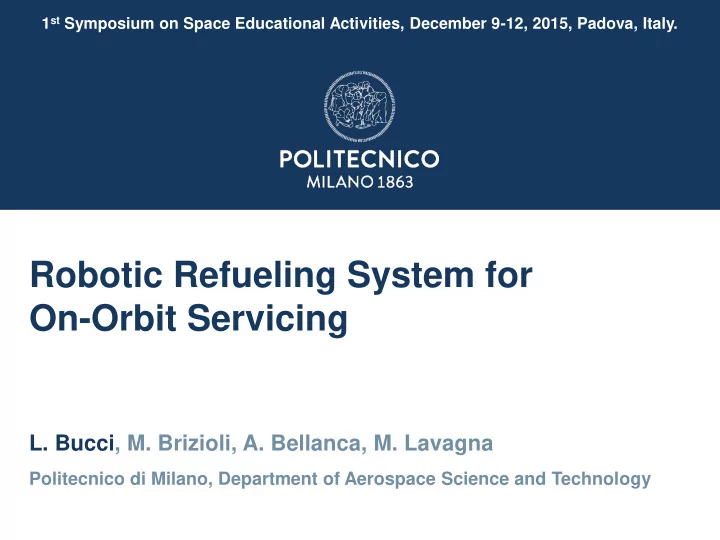

1 st Symposium on Space Educational Activities, December 9-12, 2015, Padova, Italy. Robotic Refueling System for On-Orbit Servicing L. Bucci, M. Brizioli, A. Bellanca, M. Lavagna Politecnico di Milano, Department of Aerospace Science and Technology
Introduction Feasibility study performed by 12 M.Sc. students at Politecnico di Milano. Given high level requirements: • Capability to refuel at least 3 GEO satellites • Launch in the year 2020 • Use of European launchers preferred A robotic tug was designed (Phase A), able to autonomously move in GEO, berth the clients and refuel them. Xenon is considered as fuel to be transferred, in line with near-future all-electric spacecraft trends. L. Bucci, M. Brizioli, A. Bellanca, M. Lavagna 2/14
Introduction Why On-Orbit Refueling? • Fuel depletion is one of the main constraints that limit spacecraft lifetime (up to 15 years), although payload and electronics could work for double the time. • Space launch cost nowadays is still high (7-10 k$/kg LEO, 11-30 k$/kg GEO*) • Refuelable systems would require lower fuel quantity, meaning smaller systems, lower weights and more payload. *D. E. Koelle, R. Janovsky, Development and transportation costs for space launch systems, DGLR/CEAS European Air and Space Conference, 2007 L. Bucci, M. Brizioli, A. Bellanca, M. Lavagna 3/14
Fuel transfer system: model Requirements and constraints : • Xenon kept slightly above critical conditions (289 K, 5.8 MPa) • Limits on heat power provided by the client • Minimize transfer time Transfer strategy: constant mass flow rate , controlled by Xenon Flow Controller. L. Bucci, M. Brizioli, A. Bellanca, M. Lavagna 4/14
Fuel transfer system: hardware Fuel transfer is assumed to be isobaric and isothermal , ensuring a smooth process and preventing phase changes. • Use of a pressure-regulated system (10 MPa) with helium as pressurant • Use of active thermal control to keep temperature steady (300 K) L. Bucci, M. Brizioli, A. Bellanca, M. Lavagna 5/14
Fuel transfer system: results Initial Xenon condition highly affect the transfer, due to its non-linear behavior. Results are selected to minimize active thermal control on servicer’s tanks, satisfying the client’s tanks thermal requirements. • Design mass flow rate: 2 g/s • Heat power request: 5.6 W (per g/s of mass flow rate) • Critical conditions guaranteed at the end of the transfer L. Bucci, M. Brizioli, A. Bellanca, M. Lavagna 6/14
Robotic system: overview Flexible hose Joints – 2 DOFs each To servicer Component Mass (kg) End-effector 9.5 End-effector Robotic arm 27.6 To target Flexible hose 1.37 L. Bucci, M. Brizioli, A. Bellanca, M. Lavagna 7/14
Robotic arm Tasks : • Connection between target and servicer • Fluidic link support Sizing : • Good dexterity • Trade-off between structural and kinematic tasks • Displacement at tip <0.1 mm • Strength check at root L. Bucci, M. Brizioli, A. Bellanca, M. Lavagna 8/14
End-effector It grabs the interface and provides the force to ensure engagement (350 N). Task Device Ensure and maintain valve Mechanical fingers engagement Return to initial position in Spring back safety case of malfunctioning mechanism Avoid fuel droplets Vent valve permanence L. Bucci, M. Brizioli, A. Bellanca, M. Lavagna 9/14
Validation tests: fuel transfer Test assumptions : • Mass flow rate actively regulated • Adiabatic hose The test shall validate the numerical simulations , performing a fuel transfer between two tanks on ground. Use of vacuum chamber is suggested; it is possible to avoid vacuum environment if convective heat exchange is negligible (i.e. the system is insulated). L. Bucci, M. Brizioli, A. Bellanca, M. Lavagna 10/14
Validation tests: robotic system Manipulator: • Stiffening effect due to fuel passage in the hose shall be assessed • Dexterity and capability to reach correct valve position must be tested for various configurations • Preset paths and autonomous path planning have to be validated, seeking accordance to numerical simulations End-effector: • Fingers closure and opening tests shall validate correct and safe operations • The force provided by the actuator must not be transmitted to the arm L. Bucci, M. Brizioli, A. Bellanca, M. Lavagna 11/14
In-Orbit Demonstration The whole system should be tested in-orbit. Coupled chaser-target dynamics, with flexible interface, shall be validated. • Scaling on LEO microsatellites allows cost reduction • Off-the-shelf components can be considered • Effect of small structural vibrations shall be compared to linear analysis model L. Bucci, M. Brizioli, A. Bellanca, M. Lavagna 12/14
Conclusions • Feasibility study of an OOR system (Phase A) • Driving design parameter: mass flow rate • Criticalities : autonomous operations, high cost of ground tests, challenges in thermodynamical simulations Future works • Consider carbon dioxide for ground tests • Refinement of pressure and temperature control system • Evaluate mockup complexity for testing environment L. Bucci, M. Brizioli, A. Bellanca, M. Lavagna 13/14
Thank you for your attention! L. Bucci, M. Brizioli, A. Bellanca, M. Lavagna 14/14
Recommend
More recommend